Fine artist and printmaker, Bonny Lhotka talks to Roland DG about how to be successful in the art world
Building a successful art business is challenging. There’s a lot of competition online, in galleries, at events, and in the media. In the highly-competitive fine art and photography market, artists need to be much smarter about finding pockets of interest and profit for their work. They need to recognize and act upon opportunities whenever they find them.
To become successful, artists have to not only master their craft, but also be active in the art community, attend gallery shows, art events, and build relationships in the business. However, there are even more practical steps that artists and photographers can take, and investments they can make to grow their business. After speaking with Roland DG Imaginarium Artcademy instructor and phenomenally successful artist, Bonny Lhotka, we can share some specific things fine artists can do to achieve greater success.
1. Present Yourself as a Professional
Although it’s rarely true, artists are often perceived as being “flaky.” Don’t fall into the trap of defining yourself as this type of “eccentric artist” and mimicking a perceived persona that doesn’t really exist anymore in the multi-billion-dollar fine art world. In an age where first impressions count for a lot, you need to apply the same rules that high-level business people do in their interactions with clients and contacts.

It's okay to be yourself, but you also have to present yourself as a professional in the business world.
Don’t be Casual
Treat meetings with important clients, gallery owners, and partners as any other serious professional would, by dressing for success and communicating your ideas with knowledge and clarity. Don’t be casual with your clothes, the way you speak, the time you’re supposed to meet, and the way you present your work.
Communicate Skillfully
Being an artist is not just about having artistic skills. It’s often just as important to develop interpersonal skills, so that you can talk to people about your own work, as well as what you can create for them as an artist. Use your website, work samples, and presentation skills to discuss your plans and your artistic strategies.
2. Always be Prepared
Be Organized with Samples and Business Cards
You should also be well-prepared with business cards, art samples, and the means to digitally share your work via a laptop or tablet. Gallery owners, art dealers, and consultants want to do business with talented, knowledgeable, and formidable individuals. No one wants to work with people who are ill-prepared and who give the impression that they can’t be relied upon.
Build Your Digital Content
It’s also extremely important to present your online work to people. In addition to her own website, Bonny has amassed a treasure trove of online videos, articles, and web interactions with shopfronts, galleries and online publications. This offers a lot of choice for Bonny when presenting her work. When creating your website, be distinct and professional with the content. Don’t include your travelogue or your pictures of your pets! That’s fine for social media but “professionalism” on your professional site is important. Focus on what it is you want to say about your art and what you want to sell.
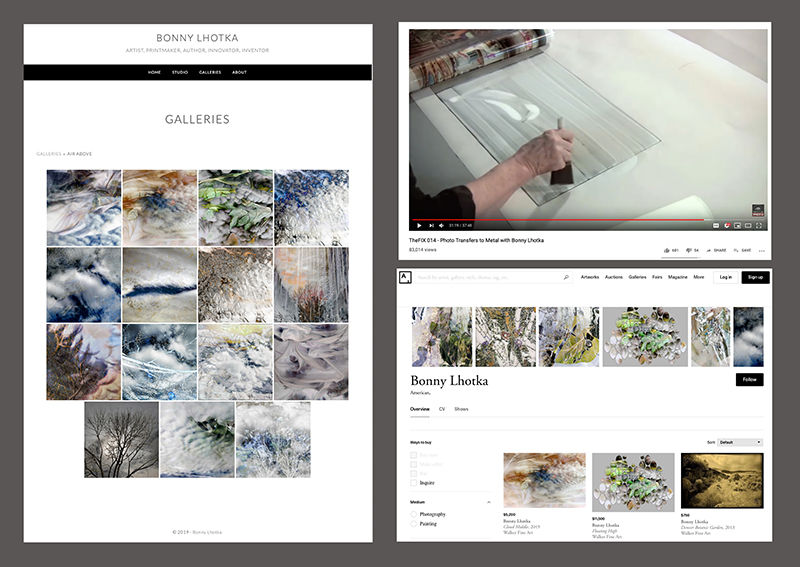
Photograph by permission of ©Bonny Lhotka
Bonny Lhotka’s website, one of her many YouTube videos, and her online shopfront where her work is available to buy – she has multiple online sources to draw from, to present her artwork, skills, and methods.
Start a Client List
Through your interactions with people, you should start building a connections list. It’s important to keep track of possible leads and opportunities, independent of galleries you may be in. However, it’s important to note that galleries do not want the artists they represent to go to gallery clients directly and it’s essential to honor gallery relationships and not sell direct.
3. Explore Different Commercial Opportunities
Only producing work that fits into a singular, creative vision, doesn’t work for Bonny and many other successful fine artists who do not see commercial opportunities as “compromising their artistic vision.” The opinion that somehow you will corrupt your artistic integrity by making commercial decisions is not only detrimental to your business but it’s also not true. Throughout the centuries, from Michelangelo’s statue of David that was commissioned by the Florentine government in Italy to the many Rothko’s that adorn the walls of some of Wall Street’s biggest companies, many of history’s greatest artworks have been created as commissioned work or commercial projects.
Create Opportunity through Company Partnerships
Bonny described to us how many of her biggest successes in fine art have been as a result of partnerships with companies and organizations. In these relationships she’s been able to talk to clients about their brand, business background, and company aims; using their PR materials, logos, photo assets, and other materials to develop a thoughtful and relevant artistic vision of their company, while still maintaining her own artistic style, technical finesse and vision.
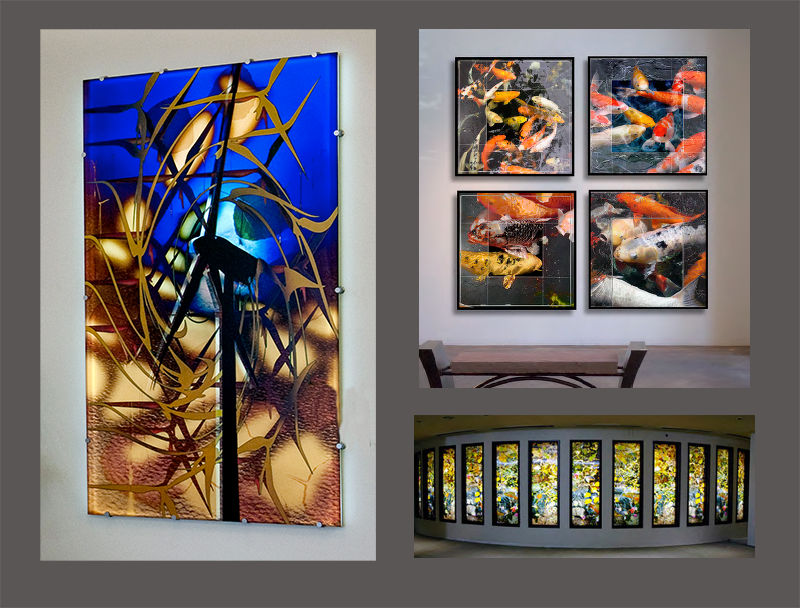
Photograph by permission of ©Bonny Lhotka
Bonny’s various commissioned projects that add meaning and elegance to company spaces— after talking to company members and researching company materials, Bonny Lhotka captures the spirit and excitement of what companies do in her art pieces.
Be Open and Flexible
If you are lucky enough to secure a commission to create art for a company, take the time to talk to people and give them what they want, rather than trying to use the opportunity to do what you want as an uncompromising artist who’s only interested in their own aesthetic. To make money in fine art, artists and photographers need to be flexible and willing to do what it takes to succeed.
Get Yourself in a Gallery
It’s easier said than done, but one of the major goals of every artist, in addition to seeking clients and commissions, should be to have your work displayed in at least one gallery. This is the equivalent of your homepage— something you can send people to and reference your work in a very physical sense. It’s often against an artist’s nature, but successful artists can’t be passive and expect galleries to come to them. You have to be somewhat of a “business hustler” as well as being a creative person. Visit galleries, talk to owners about your work, and be prepared with your contact details. Have the ability to present your work on-demand as digital or physical samples.
4. Know Your Audience and Adapt Artistically
It may not be a popular thing to say amongst creative people who want to be seen as being spontaneously creative, but artists should also have a plan and a goal, rather than jumping from one medium to the next and subject-to-subject on a whim. As an artist in this day-and-age, you should be strategic in your media use, know what subject matter you want to paint, print or photograph, and have laser-focus on who you want to appeal to with your art and what you want to achieve.
Be Flexible and Seek New Markets
Being a focused artist doesn’t mean “limiting yourself.” Artists and photographers should be constantly finding new tools and techniques to create their art— paying close attention to new technology, new mediums, and new markets. Artists should also be mindful of a new generation of older millennials who are collecting art and making art that reflects the visual nature of their generation. To appeal to a generation of older millennials who grew up in a digital age but look back with fondness at the tactile quality of oil paintings, Bonny produces art that mirrors a “high-gloss” view of the digital world as well as art that has a physical texture. She achieves this duality with Roland DG VersaUV LEF flatbed printers. Using these printers, Bonny is able to bring such generational views together through UV printing.
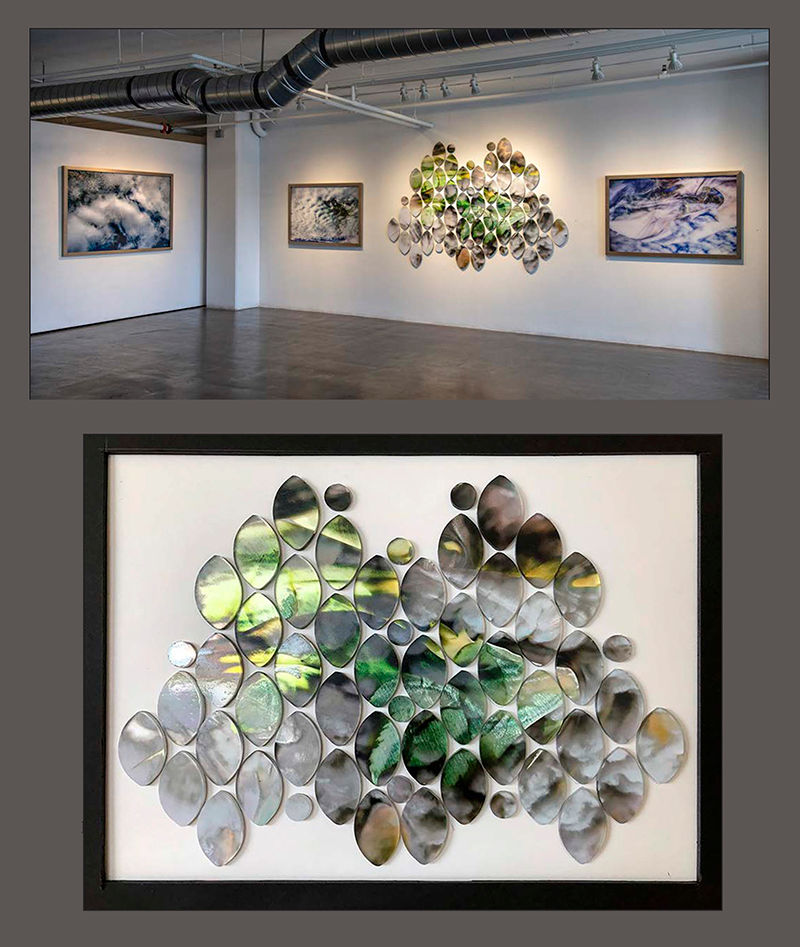
Photograph by permission of ©Bonny Lhotka
Bonny’s final 60”x 96” art exhibit (top) with a mirrored, glossy look that was showcased at the Walker Fine Art Gallery, plus, the 13”x 13” sample (bottom) she created on the VersaUV LEF-300 as a sample to present to clients.
Explore Art Beyond Pens and Brushes
While it’s important to recognize your roots as an artist, it’s also important to start looking beyond pens and brushes for ways to produce, present and reproduce your work. As a printmaker and fine artist, Bonny has created new processes with various print technologies. She uses a mixture of digital printing devices, including Roland DG UV flatbed printers as actual “art tools” to create her signature caustigrams, lithophanes, intaglio prints, white ink photography and slump molded UV prints.
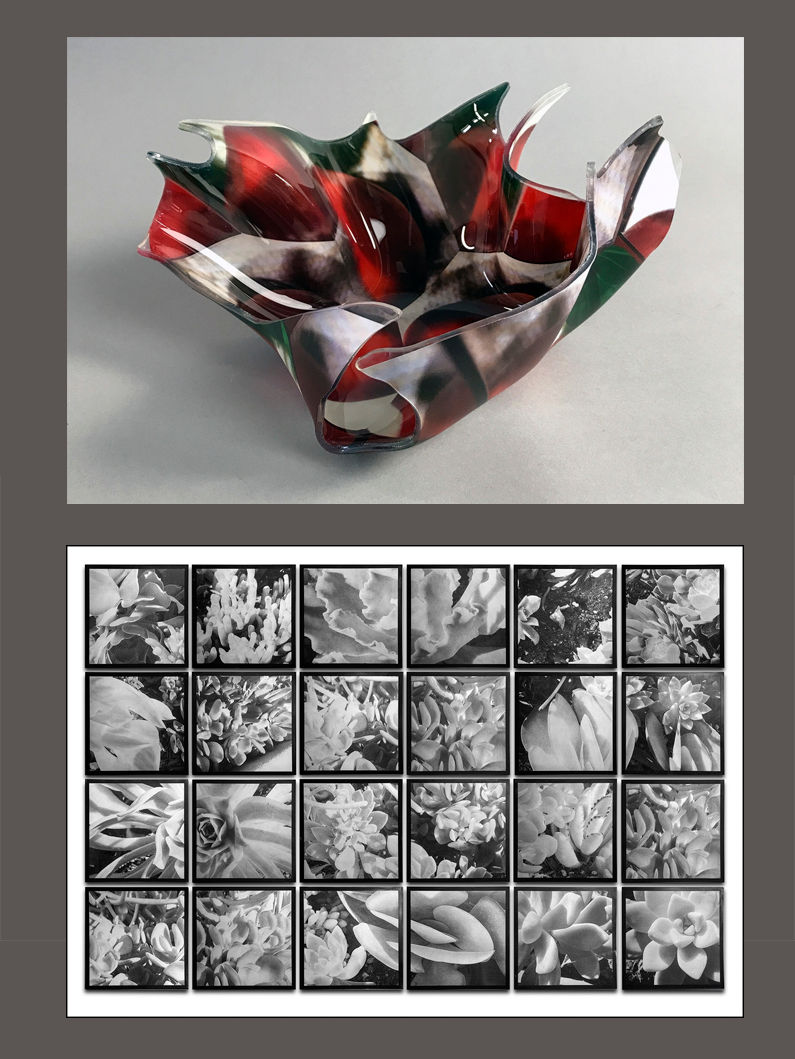
Photograph by permission of ©Bonny Lhotka
Examples of Bonny Lhotka’s work created with Roland DG UV LEF flatbed printers (top) slump mold sculptural art (bottom) artwork she created using her caustigram process
Using Print Tools for Work Samples and Resale Art Items
Using inkjet printers to reproduce your work on canvas or UV flatbed printers to create small-scale versions of your art to present to clients and consultants are great investments for artists. You can also use UV printers to add your art to products and merchandise— expanding into new ideas of product customization. People nowadays are looking for meaningful, unique objects. You can explore this profitable art avenue on online shopfronts like Etsy or create your own art reproductions to accompany your gallery shows.
Think Bigger
You should plan to take your art beyond the confines of a gallery space. Programs like the One Percent for the Arts Program are more popular than ever and present opportunities for artists in public spaces. Artists need to think in terms of making their art bigger and bolder than ever. For traditional artists, photographers, and printmakers, painting big or printing your art on large format printers for application in these spaces can be very profitable and rewarding— your art will be seen by masses of people and the exposure is huge.
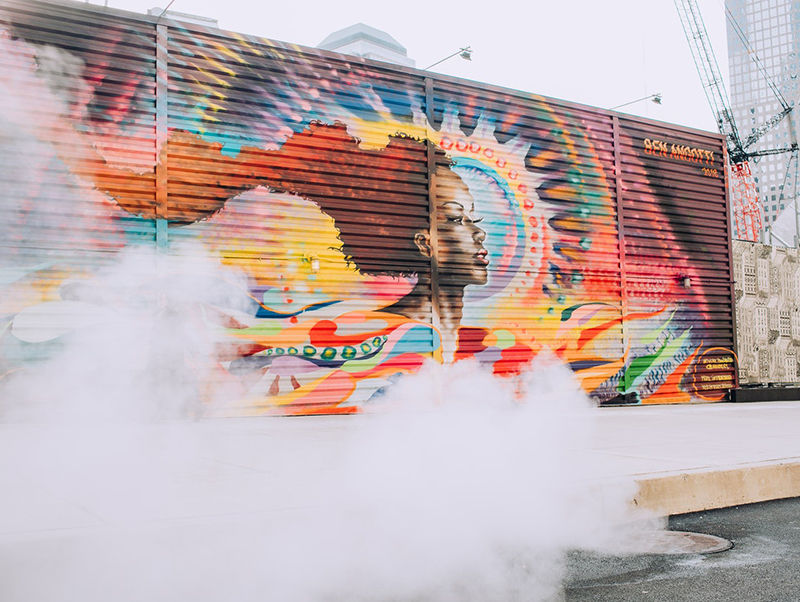
Photograph by ©Kara Muse
A popular mural by artist Ben Angotti that adorns a Brooklyn street in New York— seen and appreciated by a mass audience everyday
- In addition to having her work featured in the Smithsonian American Art Museum and many other galleries in the US, Bonny Lhotka is shown internationally and appears in numerous books and articles featuring experimental media. See more of her unique print methods and artwork that includes Roland DG printer produced pieces at her fine art website. This July, Bonny will lead our annual Roland DG Imaginarium Artcademy Workshop that showcases experimental print processes with UV flatbed printers. Check back with our News Views and How To’s Blog for more art inspiration and fine art created with UV technology and see how you can build a successful art business with Roland DG technology.


